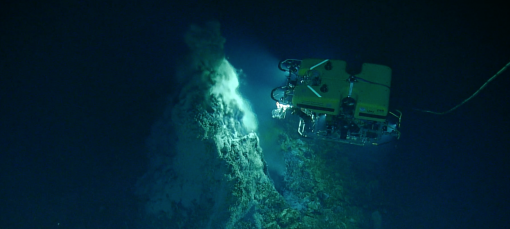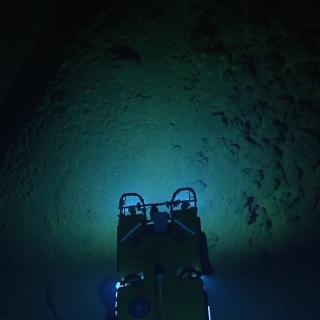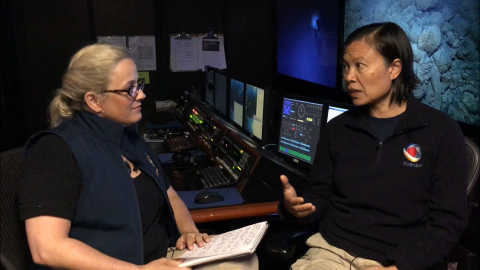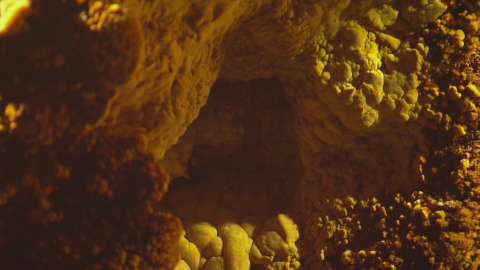Exploring Kamaʻehuakanaloa (formerly Lo'ihi Seamount) with SUBSEA

After crossing the Pacific, Exploration Vessel Nautilus will arrive in the Hawaiian Islands for the first time to launch an expedition with the SUBSEA (Systematic Underwater Biogeochemical Science and Exploration Analog) research program. This partnership between NASA Ames Research Center, NOAA OER, Woods Hole Oceanographic Institution, and various academic centers brings together both ocean and space exploration teams aboard E/V Nautilus to study how deep sea and interplanetary exploration could share similar approaches. The expedition running from August 23 - September 12, 2018 will be co-led by Dr. Darlene Lim of NASA Ames and Dr. Christopher German of the Woods Hole Oceanographic Institution.
The SUBSEA team on E/V Nautilus will explore Kamaʻehuakanaloa (formerly named Lō`ihi Seamount), an underwater volcano off the southeastern coast of the Big Island of Hawai`i. Scientists think that the ocean worlds of the outer solar system could potentially have the right conditions for microbial life, and Kamaʻehuakanaloa has similar characteristics researchers can learn from. This active hydrothermal venting site has the type of volcanic activity, water temperatures, and chemical reactions that researchers think may exist on Saturn’s moon Enceladus. The SUBSEA team will study the environmental conditions and life around the feature's hydrothermal vents, and also investigate whether this site has been affected by recent Kīlauea volcanic activity.
During the SUBSEA expedition, researchers will also test technology and scientific procedures necessary for crewed space exploration, under realistic conditions common in ocean exploration here on Earth. A human-robotic mission to the Moon or Mars might parallel SUBSEA’s mission architecture using robotic explorers controlled by humans nearby, receiving direction from a remote team of scientists. Ultimately, the results of SUBSEA’s research will inform both strategies for conducting science via teleoperations at destinations such as the Moon or Mars and scientists’ understanding of a wider range of deep-sea environments for conducting ocean world research.
The SUBSEA Lōʻihi Seamount Expedition aboard E/V Nautilus is funded by NOAA Office of Ocean Exploration and Research (OER) and the NASA PSTAR program, and is a collaboration between Ocean Exploration Trust, NASA Ames Research Center, and NOAA OER to foster collaboration between ocean and space exploration teams.
Learn more on the SUBSEA research program website.
Expedition Objectives & Dive Targets
The SUBSEA research program combines three interdisciplinary areas of study:
1) Science
The highest priority will be to extend research that has been conducted previously at hydrothermal sites within the craters near the summit of Kamaʻehuakanaloa (formerly Lo’ihi seamount). Additionally, the team will investigate whether this site has been disrupted by the recent volcanic activity associated with Kīlauea. Science and dive operations will include:
-
Geological transects and characterization of submarine volcanic environments
-
Seafloor fluid flow reconnaissance and mapping
-
Vent fluid geochemical analysis
-
Vent fluid microbial analysis
-
Plume biogeochemistry mapping and sampling
2) Science Operations
The SUBSEA team will not only be aboard E/V Nautilus--the SUBSEA Science Operations and Ethnography team will also be observing operations of a Mission Control in the Inner Space Center at the University of Rhode Island. This setup simulates future NASA missions with a minimal human presence in the field and a larger and more knowledgeable science team back at base, and multi-site coverage will allow researchers to construct a representation of workflow that represents work activities taking place simultaneously at different sites.
3) Technology
SUBSEA will use prototype information technologies that will be evaluated and iterated upon based on their ability to support science-driven low-latency telepresence operations, particularly between science teams on Earth and support crews in deep space.
Exploration & Sampling Tools
ROVs Hercules & Argus
Push cores (for sediments, bacterial mats)
Suction sampler (for microbial mats, benthic animals)
Niskin Bottles (for water samples)
Temperature Probe
Isobaric Gas Tight Samplers
SUPR (SUspended Plume Rosette) Sampler
Diffuse flow mapping surveys
MAPR (Miniature Autonomous Plume Recorder)
MISO/WHOI still camera
Kongsberg EM-302 Multibeam Echosounder
Knudsen sub-bottom profiler

Kamaʻehuakanaloa (formerly Lō`ihi Seamount)
This expedition marks the beginning of the multi-year SUBSEA (Systematic Underwater Biogeochemical Science and Exploration Analog) Research Program, a partnership between NASA, NOAA, and various academic centers. Bringing together both ocean and space exploration teams aboard E/V Nautilus, SUBSEA blends ocean exploration with ocean worlds research to address knowledge gaps related to the habitability potential of other planets in our Solar System.



